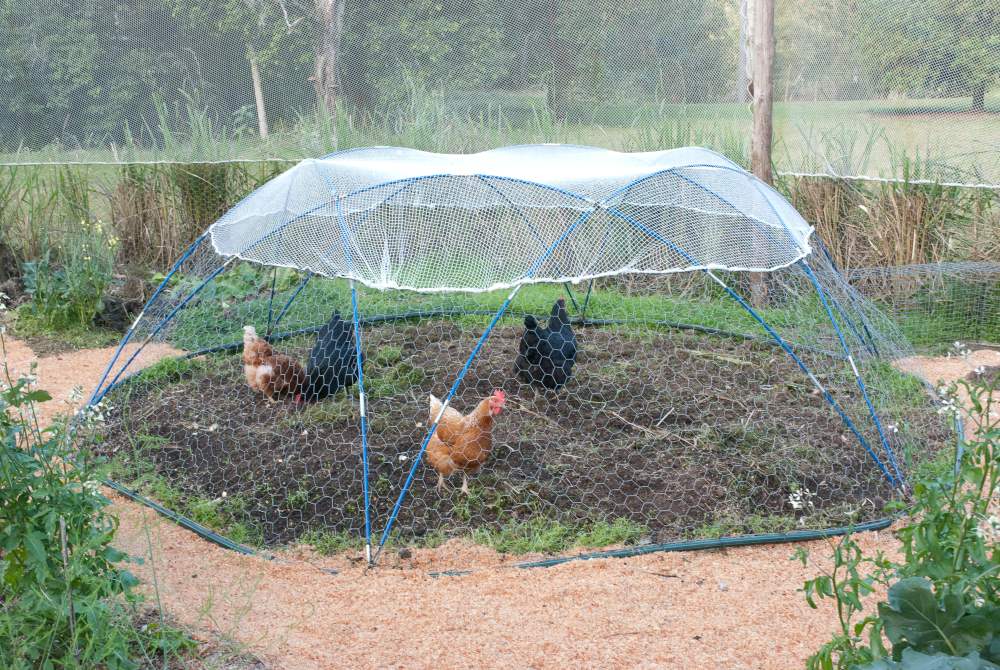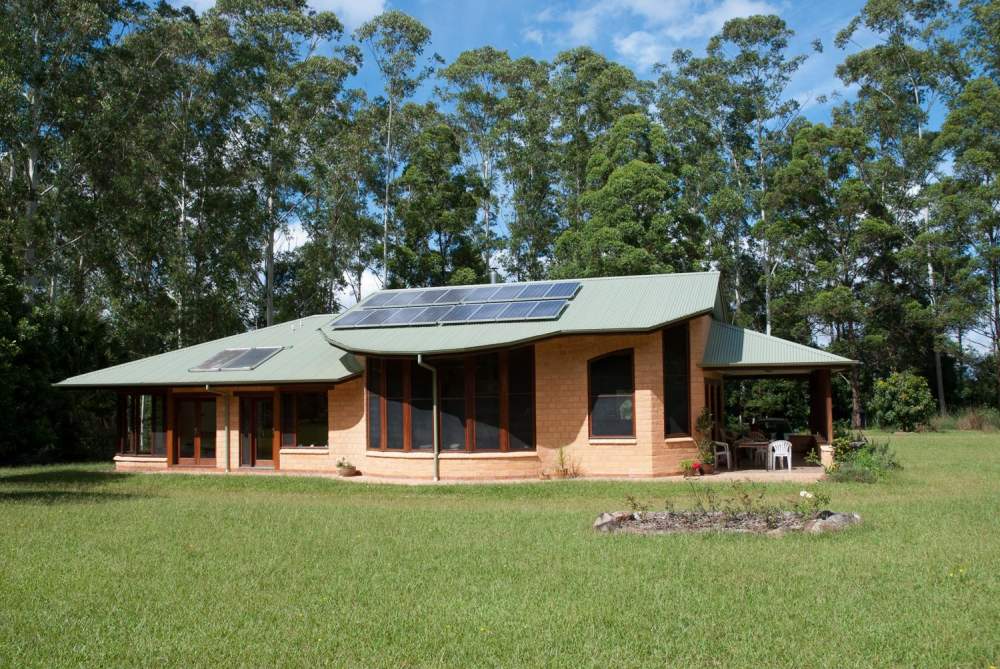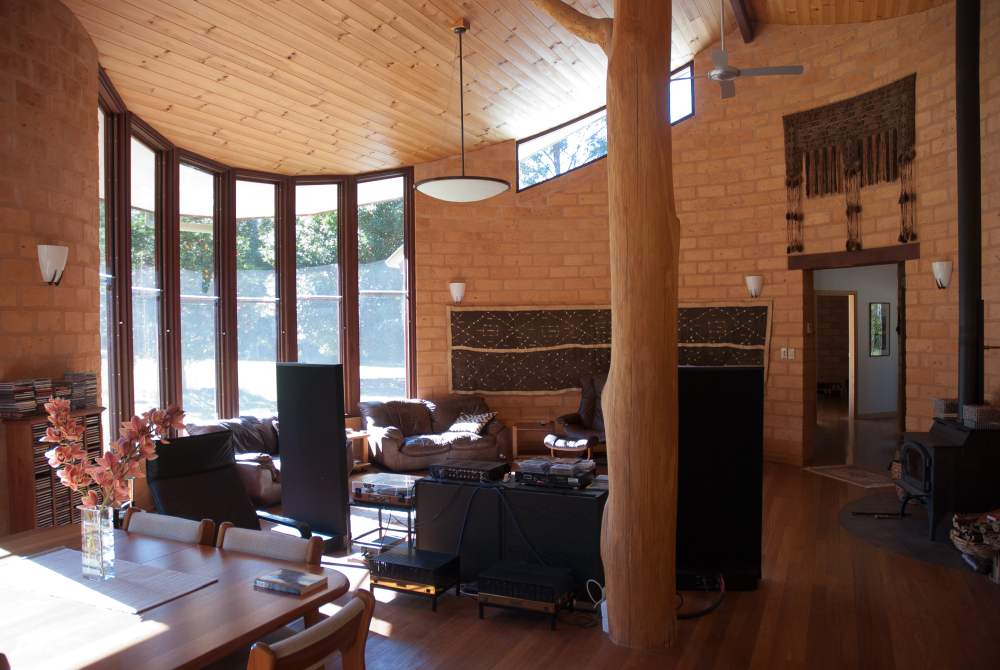Mount Olive, Upper Lansdowne - An attempt to build a comfortable sustainable house which belongs in the landscape.
The property is in the Upper Lansdowne valley on the mid north coast of New South Wales in Australia. We bought the property in 1995, and always knew it would be some time before we could move up permanently. However in 2005 we moved up, and lived in the shed so we could help while the house was being built.
While we had drawn the initial layouts of the house, it was designed by Gisela Duber, and built by her husband Walter. We were able to do some labouring, the painting and oiling and the cabinetry.
The house was designed as a passive solar design, which allows winter sun into the house, but blocks out as much summer sun as possible. As we are in quite a deep valley we do not have to worry so much about morning and evening sun on the east and west of the building which allows us to have much larger windows than normal on the sides of the house.
However the windows and the wide overhanging eves on the north side have been designed so that the angle between the tip of the roof and the bottom of the window is about the same as the angle of the sun at the equinox.
In addition the house is made of solid mud brick walls 250mm thick. While these are not very good insulators, they are very heavy, and therefore they take a long time to warm up or cool down. There are also a lot of mud brick walls inside the house, which also helps to keep the building at an even temperature. Just the bricks that are totally inside the house weigh more than 20 tons.
The result of this is that it takes several days of 40 degree weather to get the internal temperature over 26 degrees, and a cool breezy night is enough to cool the house down again, as long as the windows in the top of the living room are opened to flush the warm air out. We have installed a 7.5KW ducted airconditioner which can just keep the house comfortable on the continual runs of hot days and nights which are becomming more common.
During winter the fire warms the large curved brick wall behind it, and we use the a/c ducts to pump warm air from the main room's high ceiling into the rest of the house. This keeps the house surprisingly warm, despite the large windows with no curtains. The bedrooms do get a bit cooler than the living room but we quite like it that way.
A Beasley 5MC Roofmaster tank is installed in the roof space, and is connected both to the two Beasley SP200 panels on the roof, and to the wood burning stove, via a heat exchanger in the first length of flue.
Both the solar panels and the stove are positioned so as to allow the hot water to pump itself into the tank (thermosiphon). This happens because the hot water is less dense than the cold water and so will rise as long as the outlet pipe from the panel or stove is below the tank and rises steadily.
Because of the stove, the water in the tank can get very hot and occasionally boil, and so has to be open vented rather than sealed. However the hot water for the house does not come directly from this tank, but from a heat exchanger coil in the tank, allowing both hot and cold water to be at the same pressure, which make adjusting from hot to cold in a shower more controllable.
The system also contains an electric booster element, which has hardly ever been switched on.
We have been delighted by the performance of the system, which has reduced our electrical water heating costs to less than a dollar per year.
All the waste water from the house drains to a septic tank and from there into a 2m x 11m x 600mm reed bed. This is sealed with a plastic liner, and filled with coarse gravel to 150mm above water level, and planted with about 100 reeds of two species (Baumea articulata and Leperonia articulata). However there are a wide variety of wetland species that are effective. We have recently replaced some of the reeds with Carex appressa which should be more resistant to dry spells.
As the reed bed slopes very slightly down towards the outlet, the sewerage takes about 11 days to migrate from inlet to outlet, during which it is broken down by the bacteria living in the root zone of the reeds.
The water then collects in a sump and is pumped underground to a grid of perforated pipes under the orchard area. In Queensland it is completely legal to pump the outlet of a reedbed system directly onto vegetables, but in NSW it must be discharged underground.
We find the system never smells, and is very low maintenance, with the only chore being to cut down the reeds every few years. If you have a sloping block it can be set up so no pumps are used, though that was not possible in our situation.
We planted a small orchard some years before the house was built, mainly citrus and stone fruit. Two years after we moved in we started a veggie patch and decided to net over the stone fruit and the veggies (we have a healthy population of bower-birds and fruit bats, possums and brush turkeys and we were not getting much if any of the produce). We also started keeping chooks for eggs, and the whole system has been a success. Our design was based on The Permaculture Home Garden by Linda Woodrow which we found very useful.
The chooks have the run of the stone fruit orchard and are periodically allowed into one of the six round veggie beds, via a moveable chook dome and a system of mesh tunnels. When we have finished with the veggies in one of these beds we throw some horse manure in, put the dome over it, and open tunnel doors so they can move between it and their shed as they please. They do a great job of digging over the earth, eating up any weeds and seeds, and in about a week the area is reduced to bare earth, ready for another crop.
The garden produces most of our vegetables, and Helen (who is the brains of the outfit) has a winter and a summer guild and a rotation takes about 6 months which avoids planting the same thing at the same place repeatedlly. The little pond in the middle of the veggie patch has attracted a very helthy population of frogs.
We also have a small worm farm which ends up with any organic scraps which the chooks won't eat. Finally the bits which the worms don't handle well end up in the compost bin.




